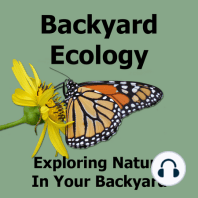57 min listen
Clovers! Native Clover Conservation, Clover Yards, and More
FromBackyard Ecology
ratings:
Length:
67 minutes
Released:
Feb 25, 2021
Format:
Podcast episode
Description
Clovers are often suggested for lawn alternatives or for incorporating into our yards to make them more pollinator friendly. Clovers can also play important roles in agriculture either in grazing systems or as cover crops in row cropping systems. In addition, they are a favorite of deer and rabbits. However, most (if not all) of the clovers in these systems and that we typically think of are exotic species. Our native clover species are not nearly as well known. In this episode of the Backyard Ecology podcast, we talk with Jonathan Kubesh. Jonathan is a PhD student at Virginia Tech University who is studying clovers. Jonathan brings a unique perspective to this topic, because although much of his work focuses on native clovers and native clover conservation, his field of study is in agriculture and agronomy. This allows him to serve as a valuable bridge between the two fields and areas of interest. While the term “clover” is often loosely used for several different genera of plants, true clovers all belong to the genus Trifolium. In the eastern U.S., we have approximately 10 different species of native clovers in the Trifolium genus. We also have a number of exotic species, such as the familiar white clovers that can be found in our yards and fields. Many of our native clovers are threatened or endangered. Some of our native clovers are tied to very special soil conditions and habitat types such as the limestone glades in the Nashville, TN area or the shale barrens which can be found in parts of Virginia, Maryland, and Pennsylvania. Other native clover species are tied to disturbance regimes that no longer exist, such as fire or short-term, intensive grazing by bison or deer. In our conversation, Jonathan and I discuss many different topics. A large part of our conversation is devoted to native clovers. Our discussion about native clovers covers their biology, the conservation efforts surrounding them, how agriculture and horticulture may play a role in those conservation efforts, the importance of keeping good records, and the valuable role of historical collections and herbarium records in helping to discover new populations and in guiding restoration efforts. Jonathan and I also talk about establishing clover yards and some of the factors that you might want to consider when deciding whether a clover yard is right for you. Like with so many other things in life, there isn’t one single answer that will fit all situations. However, Jonathan does an excellent job of discussing possibilities for different situations and for pointing us towards how to find more specific local help for determining the best option for our own unique situations. Links: Jonathan’s research: Edaphic and morphological factors affecting running buffalo clover (Trifolium stoloniferum) ecology Native Clover Conservation In The Bluegrass: An Agronomic Perspective Other resources recommended by Jonathan: Planting Guide to Grasses and Legumes for Forage and Wildlife in Georgia Simple Strategies for Profitable Forage Production Trifolium kentuckiense (Fabaceae, Papilionoideae), A New Species from Franklin and Woodford Counties, Kentucky Jonathan’s social media pages: Facebook Instagram Jonathan’s email: jakubesch@gmail.com Backyard Ecology’s website Here’s the episode with Dwayne Estes that we referred to several times My email: shannon@backyardecology.net Episode image: Trifolium reflexum growing in Jonathan’s seed trials Photo credit: Jonathan Kubesh
Released:
Feb 25, 2021
Format:
Podcast episode
Titles in the series (92)
Growing Native Plants in Small Yards: Growing Native Plants by Backyard Ecology
